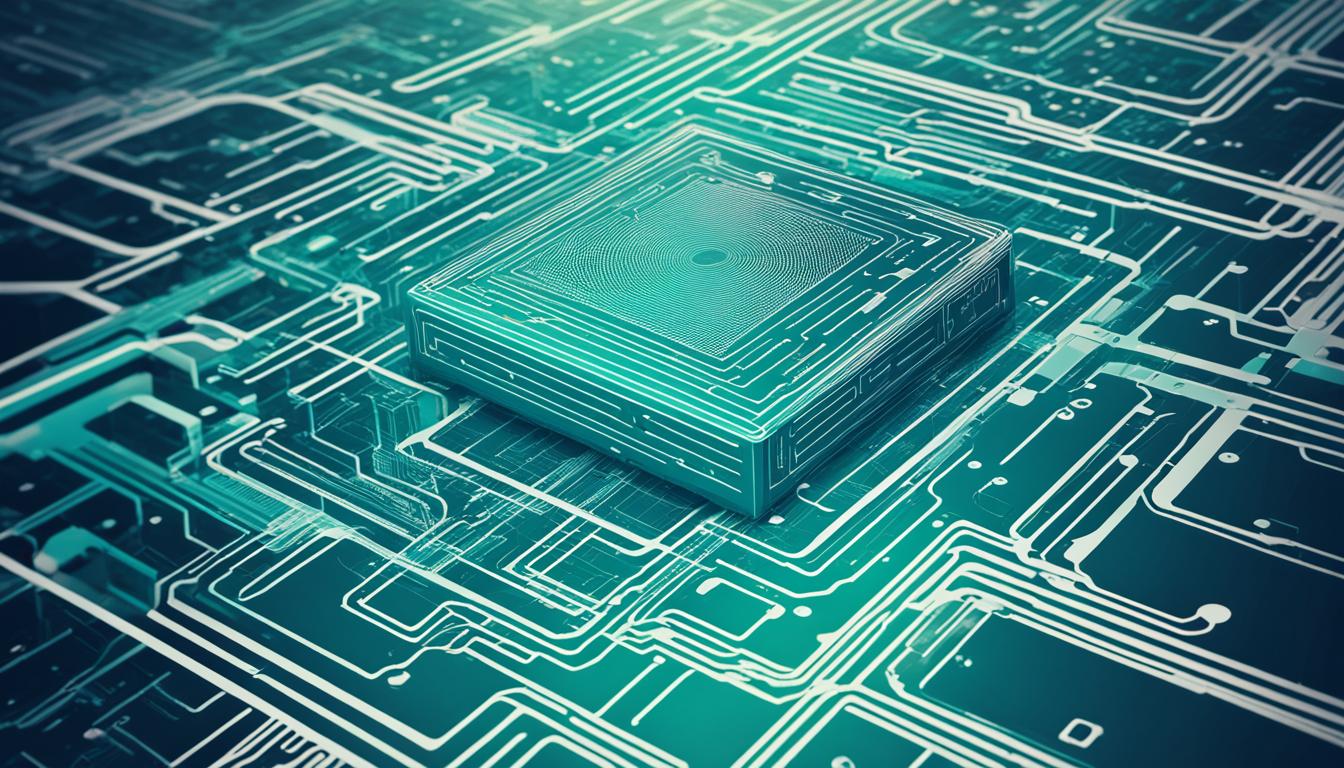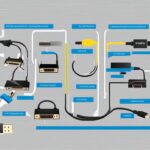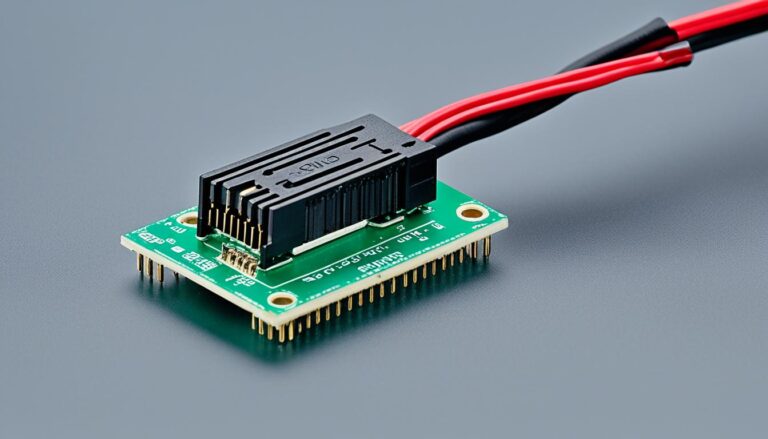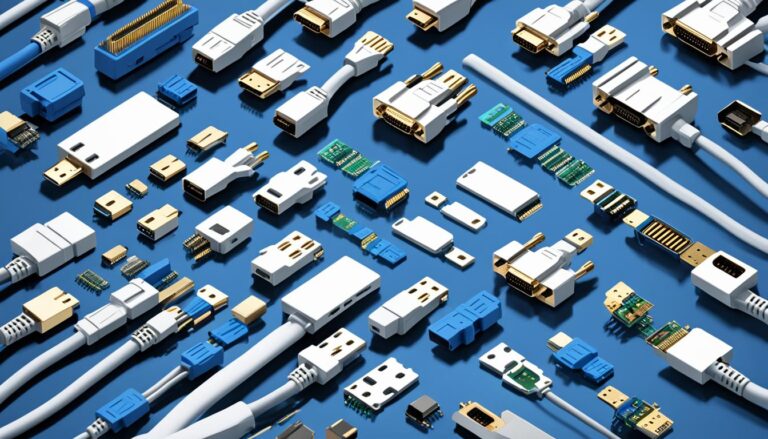The ethernet connector symbol is key in today’s connectivity world. It helps users know and tell apart various ethernet cables. These include Cat5e, Cat6, and Cat6a. Each type has its specs and standards.
By looking at the symbol, people can learn about the cable’s category and much more. This includes shielding type, certifications, and wire size. This knowledge is vital for choosing the right cable for your needs.
Understanding these details is important when picking the right ethernet cable. This is true for both home and business needs. Get ready to dive deeper into ethernet cable types, decoding jacket info, and why shielding and standards matter.
Understanding Ethernet Cable Categories and Specifications
Ethernet cables come in different types. They vary in how fast they transfer data and their bandwidth abilities. Some well-known types are Cat5e, Cat6, and Cat6a. These are chosen based on what the user needs.
Cat5e: Cat5e cables are an improved version of the 5th category. They can handle speeds up to 1Gbps over 50 meters. With a 350MHz bandwidth, they’re perfect for home use and small offices. They support normal internet activities and basic network tasks well.
Cat6: Cat6 cables are from the 6th category and are better than Cat5e. They have up to 550MHz bandwidth. This allows them to carry data at speeds up to 10Gbps over 50 meters. They are great for activities that need faster data, like streaming and online gaming.
Cat6a: Cat6a cables are an even better version of the 6th category. They can move data up to 10Gbps but over 100 meters. With a bandwidth of 750MHz, they’re best for high-demand settings. This includes data centres and big networks that need fast, reliable connections.
Cat6 and Cat6a cables come in two types: shielded and unshielded. Shielded cables are great at blocking interference. Unshielded ones are more flexible and cheaper, good for most network needs that don’t need extra shielding.
“Cat5e, Cat6, and Cat6a are the most commonly used ethernet cable categories. Each category has its own strengths to fit different network needs.”
Decoding Ethernet Cable Jacket Descriptions
Choosing the right ethernet cable is vital. The cable jacket holds key details. It helps identify the specifications and characteristics of the cable.
Is the cable shielded or unshielded? This is a crucial detail. Shielded cables (STP) have extra layers to protect against interference. Unshielded cables (UTP) are more flexible and cheaper, fitting most needs.
To understand the cable’s performance, look at the jacket. It tells you about the shielding. You might see foil, braided shielding, or both.
The cable jacket also mentions the American wire gauge (AWG). A lower AWG means a thicker conductor. This conductor can handle more data and longer distances.
What about the core? By examining it, you’ll know if it’s pure copper or copper-clad aluminum. Pure copper is more conductive and durable. Copper-clad aluminum is lighter and cheaper.
Example of an Ethernet Cable Jacket Description:
Ethernet Cable Jacket Description:
- Category: Cat6a
- Shielding: STP (Foil + Braided)
- AWG: 23
- Conductor Type: Pure Copper
Knowing these details helps you make the best choice. You can pick the perfect cable for your home, office, or data center.
| Specification | Shielded Ethernet Cable (STP) | Unshielded Ethernet Cable (UTP) |
|---|---|---|
| Advantages | Better protection against EMI and crosstalk | Flexibility and cost-effectiveness |
| Suitable for | Areas with high levels of electromagnetic interference | Most common networking applications |
| Shielding Type | Foil shielding, braided shielding, or both | N/A |
| Conductor Type | Pure copper or copper-clad aluminum | Pure copper or copper-clad aluminum |
Significance of Ethernet Cable Shielding and Standards
Ethernet cables are vital for good networking connections. Shielding and following standards improve their performance and longevity. This section discusses why Ethernet cable shielding matters and how adhering to standards ensures the best connectivity.
The Advantages of Ethernet Cable Shielding
Ethernet cables come as shielded (STP) or unshielded (UTP) types. Shielded cables protect against crosstalk and electromagnetic interference (EMI). This extra shield keeps signals clear by lessening the effect of outside electrical noise. It ensures data is sent reliably and consistently.
In places with lots of electromagnetic interference, like industrial zones or data centres, shielded cables excel. They’re made to overcome EMI, allowing clear communication even in tough conditions.
The Flexibility and Cost-Effectiveness of Unshielded Ethernet Cables
Unshielded Ethernet cables, or UTP cables, are widely used for their flexibility and lower cost. They use twisted pairs of copper wires to resist noise naturally. Although not as protective as shielded cables, UTP cables work well for most network needs, from homes to businesses.
UTP cables are thinner and easier to sort, perfect for complex cable setups. They are also budget-friendly, making them appealing for cost-conscious businesses.
Importance of Ethernet Cable Standards and Certifications
Choosing Ethernet cables means checking they meet industry standards. Organizations like UL (Underwriters Laboratories) and EIA/TIA (Electronic Industries Association/Telecommunications Industry Association) set these benchmarks. They ensure cables are safe and perform well in networking tasks.
Following these standards means trusting your Ethernet cables for reliable connections. It covers conductor size, data transfer rates, and bandwidth. Using standard-compliant cables avoids compatibility problems and ensures devices work smoothly together.
| Ethernet Cable Shielding | Advantages | Disadvantages |
|---|---|---|
| Shielded (STP) | Enhanced protection against crosstalk and EMI | Thicker profile, higher cost |
| Unshielded (UTP) | Flexibility, cost-effectiveness | Lower EMI protection |
Choosing the right Ethernet cables with shielding and standard compliance is key to a strong network. Whether fighting EMI or reaching performance goals, the correct cables promise reliable data transfer, few network problems, and the best connectivity for all.
Importance of Understanding Ethernet Wiring Terminology
Ethernet networking has a lot of special terms. Knowing these terms well is vital for a deep understanding of ethernet connections. By learning the correct meanings and uses, you can talk more clearly. You’ll also be better at picking the right ethernet cables. Two important terms are RJ45 and twisted pair wiring.
RJ45: The Standard Ethernet Connector
An RJ45 connector, or 8P8C connector, is the standard for ethernet cables. It has eight gold-plated pins that match the cable’s eight wires. These connections allow data to flow dependably. RJ45 connectors are preferred in networks because they are strong and work with many ethernet tools.
Twisted Pair Wiring: Minimizing Interference
Twisted pair wiring is a special kind of ethernet cable. It has pairs of copper wires twisted together. This design reduces crosstalk and electromagnetic noise. By twisting the wires, signal problems from outside noise are lessened. This means data moves more smoothly and reliably. There are two types: shielded (STP) and unshielded (UTP).
“Understanding the differences between STP and UTP twisted pair wiring is crucial for selecting the right ethernet cables for specific networking needs.”
Shielded (STP) cables have an extra foil or braid layer. This shields them from outside noise. They are often used where there’s a lot of electromagnetic noise. Think industrial areas or places with many electronic devices.
Unshielded (UTP) cables don’t have this extra shielding. They’re more flexible and easier to set up. Plus, they’re more affordable. This makes them a good choice for many homes and offices.
Knowing about ethernet wiring terms helps you choose the right cables. Whether for home, work, or industrial settings, understanding RJ45 and twisted wiring is key. This way, you’ll always pick the best cables for your network needs.
Conclusion
Choosing the right ethernet cable starts with the ethernet connector symbol. This symbol tells us about the cable’s category, shielding, and size. It helps us know what we’re getting.
Reading the cable’s jacket lets us choose wisely for our home or business network.
When looking for ethernet cables, think about data speed, bandwidth, and shielding. Also, check if they meet industry standards. These factors are key for good internet whether for gaming or work.
Noting the ethernet connector symbol can guide us to the right choice. Good performance and avoiding issues rely on picking a compatible cable with your devices. Remember this symbol and your needs next time you’re buying an ethernet cable. This will ensure you get the connectivity you need.
FAQ
What is the significance of the ethernet connector symbol?
The ethernet connector symbol is vital for identifying ethernet cables. It makes it easy to tell different types apart.
What are the different categories of ethernet cables?
Common ethernet cables are Cat5e, Cat6, and Cat6a. Each has different capabilities.
What are the specifications of Cat5e cables?
Cat5e cables can transfer data up to 1Gbps. They work over 50 meters with a 350MHz bandwidth.
What are the specifications of Cat6 cables?
Cat6 cables support a 550MHz bandwidth. They allow 10Gbps speeds over a distance of 50 meters.
What are the specifications of Cat6a cables?
Cat6a cables handle 10Gbps over 100 meters. Their bandwidth reaches up to 750MHz.
How can I identify the specifications of an ethernet cable?
Check the jacket inscriptions for its category, shielding, certifications, and conductor size.
What is the difference between shielded and unshielded ethernet cables?
Shielded cables protect against interference while unshielded ones are more flexible and cheaper.
What industry standards should I consider for ethernet cables?
Your ethernet cable should meet standards like UL and EIA/TIA. This ensures quality and safety.
What is the importance of understanding ethernet wiring terminology?
Knowing terms like RJ45 helps in selecting the right ethernet cables. It ensures clear communication.
How does the ethernet connector symbol help in ethernet cable selection?
The symbol, along with cable jacket info, guides users in picking the best cable for their needs.












